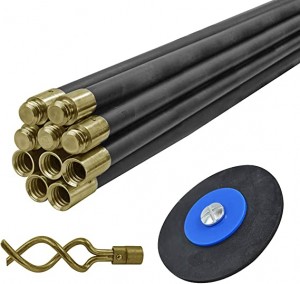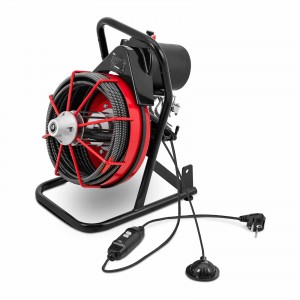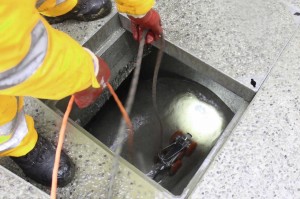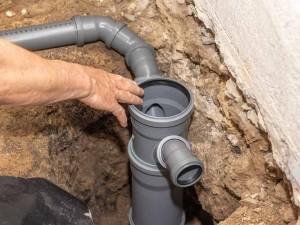Drainage Company Common Questions
These drainage questions are some of the very many questions we encounter on a regular basis. They cover some of the varied drainage problems that our customers face on a regular basis. Some are straight forward and some are a little strange, but we always do our best to answer our customers drainage issues.
Are Drain Rods flexible?
Yes, drain rods are semi-flexible. They are typically made up of separate threaded sticks that can be easily connected to reach different depths. While they do have some degree of flexibility,  allowing them to navigate bends in the drainage system, they aren’t as flexible as more specialized tools like drain snakes or other robust cabling equipment. Drain rods are commonly used for basic blockage removal and maintenance tasks wherein moderate bending is anticipated.
allowing them to navigate bends in the drainage system, they aren’t as flexible as more specialized tools like drain snakes or other robust cabling equipment. Drain rods are commonly used for basic blockage removal and maintenance tasks wherein moderate bending is anticipated.
What is the best way of cleaning drains in bathroom sinks?
Here’s a clear step-by-step guide to cleaning a bathroom sink drain:
1. Start by removing visible debris or hair near the surface of the drain using gloves or tweezers.
2. Create a mixture by combining equal parts hot water and vinegar or baking soda. The heat helps dissolve grease and grime, while vinegar/baking soda act as natural cleaners.
3. Pour the mixture down the drain and let it sit for 10-15 minutes, allowing it to penetrate and break down any build-up within the pipe.
4. Afterward, thoroughly flush the drain with hot water for several minutes to rinse away loosened debris and residue.
Using this method regularly can help keep your bathroom sink drains clean and odour-free!
Are there any risks of cleaning a drain with bleach?
the risks of cleaning a drain with bleach:
Cleaning a drain with bleach carries some potential risks that should be considered:
1. Toxic fumes: Bleach contains chemical compounds that produce strong fumes, which can be harmful if inhaled excessively. It is important to use bleach in a well-ventilated area or consider wearing a mask to minimize exposure.
2. Pipe damage: Regular and excessive use of bleach can potentially deteriorate certain types of pipes over time. This is especially true for older or more delicate plumbing systems. Bleach may corrode or weaken pipes made of materials like PVC (polyvinyl chloride) or rubber.
3. Environmental impact: When bleach enters the drainage system, it eventually makes its way into water sources and ecosystems. The chemicals in bleach can have adverse effects on aquatic life and contribute to water pollution.
To minimize these risks, it’s advisable to use alternative drain cleaning methods such as enzymatic cleaners, baking soda and vinegar solutions, or seeking professional help from drain cleaning services when necessary. If you do choose to use bleach, always follow safety guidelines provided on the product label and avoid using excessive amounts.
Cleaning a drain with snake?
Cleaning a drain with a snake, (no, it’s not cruel) also known as a drain auger or plumber’s snake, is a common method used to remove clogs and blockages from pipes. Here’s what you need to  know about cleaning a drain with a snake:
know about cleaning a drain with a snake:
1. Understanding the tool: A drain snake is a long, flexible metal cable with an auger or corkscrew-like tip at one end. It is designed to be inserted into drains and rotated manually or powered by a motorized device.
2. Locating the clog: Before using the snake, it’s important to identify the location of the clog in your drainage system. This can help determine which access point (such as sink trap or cleanout) you should use to insert the snake.
3. Inserting the snake: Carefully feed the end of the snake into the drain opening while turning it clockwise. Apply gentle pressure but avoid forcing it too aggressively, as this could damage your pipes.
4. Breaking up and removing the clog: As you continue inserting and rotating the snake, its auger tip will catch onto debris and break up obstructions in your pipe. You may feel resistance initially but keep rotating until you can freely move through the pipe.
5. Retrieving or flushing out debris: Once you’ve broken up the clog, slowly withdraw the snake from your drain while continuing to rotate it if necessary. Dispose of any collected debris properly or flush it away with water.
6. Flushing and testing: After clearing out any visible obstruction, run hot water down your drain for several minutes to ensure that water flows freely without any remaining blockages.
It’s worth noting that using a plumbing snake requires caution to prevent injury or damaging pipes further; if unsure about how to use one correctly, consulting a professional drainage company is recommended.
What are the costs of relining drain pipes?
The cost of relining drain pipes can vary depending on several factors, including the length and diameter of the pipes, the severity of damage or blockage, and the specific materials used for relining. Additionally, prices may differ between different regions in the UK.
As a rough estimate, drain pipe relining costs can range from £85 to £350 per metre of pipe. This price typically includes all necessary preparation work, such as cleaning and inspecting the pipes before relining.
It’s important to note that this is just an approximate cost range and actual prices may vary based on individual circumstances. To get an accurate quote for your specific drain pipe relining needs, it’s recommended to contact professional drainage companies who can assess your situation and provide a detailed cost estimate tailored to your requirements.
DIY drain relining, can an amateur do this?
DIY drain relining is possible, but it is generally not recommended for amateurs or inexperienced individuals. Drain relining involves specialized equipment and techniques that require a certain level of expertise to ensure proper installation and long-lasting results. 
Here are a few reasons why DIY drain relining may not be suitable for amateurs:
1. Technical knowledge: Drain relining requires an understanding of the specific materials, tools, and processes involved. Without proper knowledge, there is a risk of making mistakes that could lead to further damage or ineffective repairs.
2. Equipment requirements: DIY drain relining typically requires specialized equipment such as resin impregnated liners, inflation devices, and curing systems. These tools may not be readily available to amateurs without access to professional-grade equipment.
3. Safety considerations: Working with chemicals and potentially hazardous substances during the relining process can pose risks if proper safety precautions are not followed. Professionals are trained in handling these materials safely.
4. Quality assurance: Professional drainage companies have experience in assessing the condition of pipes accurately and determining whether relining is the appropriate solution. They can also provide warranties or guarantees on their workmanship.
It’s advisable to consult with experienced drainage professionals who specialize in drain relining services for effective and reliable results. They have the necessary expertise, equipment, and knowledge to ensure a successful outcome while minimizing potential risks or complications associated with DIY attempts.
What are the best methods of drain cleaning?
There are several effective methods of drain cleaning, and the best method depends on the severity and nature of the clog. Here are some commonly used methods:
1. Plunging: Plungers can be highly effective for clearing simple blockages in sinks, toilets, or showers. Create a seal around the drain opening with the plunger and vigorously push and pull to create suction that dislodges the clog.
2. Drain snakes or augers: These tools are useful for reaching deeper clogs. Insert the snake into the drain and rotate it to break up or retrieve the obstruction.
3. Baking soda and vinegar: This natural solution can help dissolve minor blockages caused by organic matter. Pour half a cup of baking soda down the drain, followed by half a cup of vinegar. Let it fizz for about 15 minutes before flushing with hot water.
4. Enzyme-based cleaners: These cleaners contain bacteria or enzymes that break down organic matter in drains over time, helping to prevent build-up and keep drains flowing smoothly.
5. Hydro-jetting: This method involves using high-pressure water jets to clear stubborn blockages or remove accumulated debris from pipes effectively. It is typically performed by professionals due to its specialized equipment requirements.
6. Professional drain cleaning services: If home remedies don’t work or if you have persistent or severe clogs, contacting professional drainage companies is recommended. They have access to advanced tools like hydro-jetters, CCTV cameras for inspections, and expertise in diagnosing and resolving complex drainage issues.
The choice of method depends on factors such as accessibility, severity of blockage, personal preference, and available resources. It’s important to use caution when attempting DIY methods and seek professional assistance if needed.
What is drain cleaning acid and is it safe?
Drain cleaning acids are chemical substances designed to dissolve or break down tough clogs, such as hair, grease, or mineral deposits in drains. One common type of drain cleaning acid is sulfuric acid.
While drain cleaning acids can be effective at removing certain types of blockages, they also come with potential risks and safety concerns. Here’s what you need to know:
1. Safety precautions: Drain cleaning acids are highly corrosive and can cause severe burns if they come into contact with the skin or eyes. It is crucial to wear protective gear like gloves and goggles when handling these chemicals.
2. Toxic fumes: Acidic cleaners can produce strong and potentially harmful fumes that should not be inhaled. Adequate ventilation is essential during use.
3. Pipe damage: Some types of pipes, such as PVC (polyvinyl chloride), rubber, or older metal pipes, may be vulnerable to damage from acidic cleaners. Prolonged exposure or improper use of drain cleaning acids can lead to pipe corrosion or weakening over time.
4. Environmental impact: The disposal of drain cleaning acids must be done responsibly following local regulations since they can harm the environment if not handled properly.
Given the risks involved with using drain cleaning acids, it’s generally recommended to explore alternative methods first, such as plunging, snaking, or using natural solutions like baking soda and vinegar. If these methods prove ineffective for stubborn clogs, it’s strongly advisable to seek professional help from experienced drainage experts who have access to safer yet powerful commercial-grade products specifically formulated for drain clearing.
What is a drain cleaning air gun and what is it used for?
A drain cleaning air gun, also known as a drain blaster or drain plunger gun, is a tool used for clearing clogs in drains and pipes. It operates on the principle of compressed air to create pressure and dislodge blockages. Here’s what you need to know about drain cleaning air guns:
1. How it works: A drain cleaning air gun consists of a handheld device with a trigger mechanism and a rubber or plastic attachment that fits over the drain opening. When the trigger is pressed, it releases a burst of compressed air into the pipe.
2. Creating pressure: The sudden release of compressed air creates high-pressure force inside the pipe, which can help push or blast away obstructions such as hair, debris, or minor clogs.
3. Versatility: Drain cleaning air guns are typically used for smaller household drains like sinks, showers, or toilets. They may not be suitable for larger drains or more severe blockages that require professional intervention.
4. Safety precautions: While using an air gun may seem straightforward, it’s important to follow safety guidelines provided by the manufacturer. Wear protective eyewear and ensure proper ventilation when operating these devices.
5. Limitations: Drain cleaning air guns are generally effective for simple clogs caused by organic matter but may not be as effective against solid objects or stubborn blockages deep within the plumbing system.
It’s worth noting that while drain cleaning air guns can provide temporary relief from minor clogs, persistent or severe blockages may require professional assistance to properly diagnose and resolve underlying issues.
Drain cleaning and camera inspection
Drain cleaning and camera inspection are two essential services offered by drainage companies to diagnose and resolve issues in drains and sewer lines. Here’s what you need to know about each:
1. Drain Cleaning: Drain cleaning involves the removal of blockages, debris, or build-up that can impede the flow of water through drains. It is typically done using various methods such as plunging, snaking (using drain augers), hydro-jetting (high-pressure water jets), or chemical cleaners. 
The goal of drain cleaning is to restore proper drainage by clearing clogs caused by hair, grease, soap scum, food particles, or other materials that accumulate over time. Regular drain cleaning maintenance helps prevent blockages and maintain optimal performance.
2. Camera Inspection: Camera inspection involves using a small waterproof camera attached to a flexible cable that is inserted into the drain or sewer line. The camera provides real-time video footage of the interior of the pipes, allowing professionals to visually inspect their condition.
Camera inspections are useful for identifying various issues such as cracks, leaks, tree root intrusions, pipe misalignments, corrosion, or other structural defects within the drainage system. This visual assessment helps determine the appropriate course of action for repairs or replacements.
By combining drain cleaning with camera inspection services when necessary, drainage companies can accurately identify underlying problems causing recurring blockages or poor drainage performance. This enables them to provide targeted solutions tailored to specific issues in order to ensure effective and long-lasting results.
It’s important to note that both drain cleaning and camera inspection services are best performed by trained professionals who have the expertise and specialized equipment required for accurate diagnosis and safe execution.
We hope you found the above helpful. If you need any help rom a professional drainage repair company covering Derby, Nottingham, Sheffield, Stoke on Trent and Chesterfield, then please contact us today.

